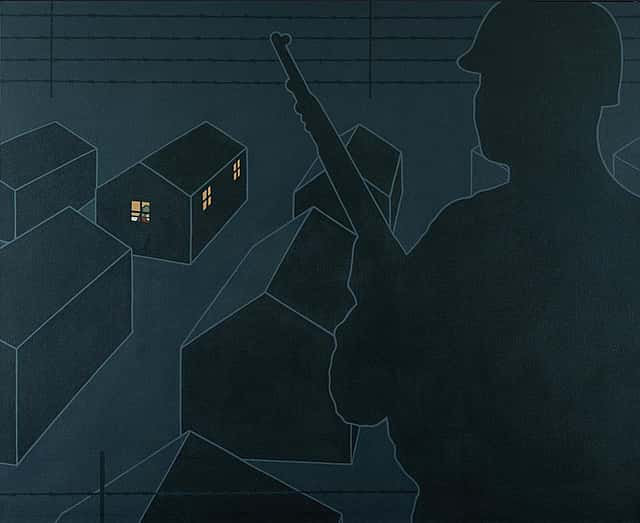
Silent Shadows: Art, Internment, and the Legacy of Minidoka
The “Minidoka on My Mind” collection sits somewhere between memories and creativity. Created by Japanese American artist Roger Shimomura, the three painting collection challenges traditional Japanese art forms while addressing a personal and cultural past. Through his imagery and bold art choices, Shimomura draws heavily from his family’s relocation and the public mindset during the mass incarcerations of Japanese Americans during WWII. Best known for blending pop art with personal history, Shimomura used dark colors and flattened shapes to create simple but powerful works of art that convey important messages.
Behind the Art

Born in Seattle, Washington in 1939, Roger Shimomura spent his early childhood under forced relocation at the Minidoka Relocation Center in Idaho—one of ten incarceration camps in the Mountain West set up by the government during World War II. At only three years old, Shimomura was too young to fully remember the experience, but years later he turned to his grandmother’s diary for insight. Her daily entries became a significant influence on his art and understanding of his grandmother’s life in the camp.
One entry from October 16, 1942, simply reads: “How monotonous life is here. Again, another day passed wastefully doing laundry and miscellaneous things. I wondered how anyone in this camp could live here without a deep sense of boredom.”
After the war, Shimomura went on to study at Washington State University and earned his MFA from Syracuse University. He later became a well-respected professor at the University of Kansas, where he taught for over three decades. He stayed committed to telling stories through his art all those years.
Shimomura’s style blends pop art, and clean imagery. On the surface, his paintings seem simple—muted figures, flat backgrounds, comic book-like lines—but each image invites a tale. He often pairs lighthearted or familiar visuals with serious, complex topics. Through just three acrylic paintings, Shimomura captures the feeling of camp life. The figures in his work often look like they’re on stage—posed, frozen, unmoving. Perhaps the artist creates that theatrical stillness to reflect how history sometimes is so surreal it seems scripted.
“Minidoka on My Mind”
One of the most discussed paintings in the series is Shadow of the Enemy. It shows a young girl skipping rope outside the camp barracks. At first glance, it seems playful, but her shadow tells a different story. Perhaps Shimomura uses this image to highlight how even children suffered in the internment camps.

That kind of duality runs through all of the pieces. Each painting tells a story— Night Watch #2 is a painting of a guard standing alert during the night with the sea of barracks in front, and the Portrait of a Barrack, reflects on the development and reality of the dwellings that Japanese-Americans lived in. The Portrait of a Barrack is a great example of the imagery and sharpness of Shimomura’s artwork.
Shimomura’s art to reminds people of the injustice perpetrated on Japanese-Americans. Although Shimomura was incarcerated at the Minidoka camp in Idaho, his artwork speaks to the experiences of the people incarcerated at all 10 camps. Through his work, he ensures people remember the relocation and history of Japanese Americans during WWII.
Written By
Emma Brence
Emma Brence is a summer intern at the Buffalo Bill Center of the West and a full-time student at Laramie County Community College.
